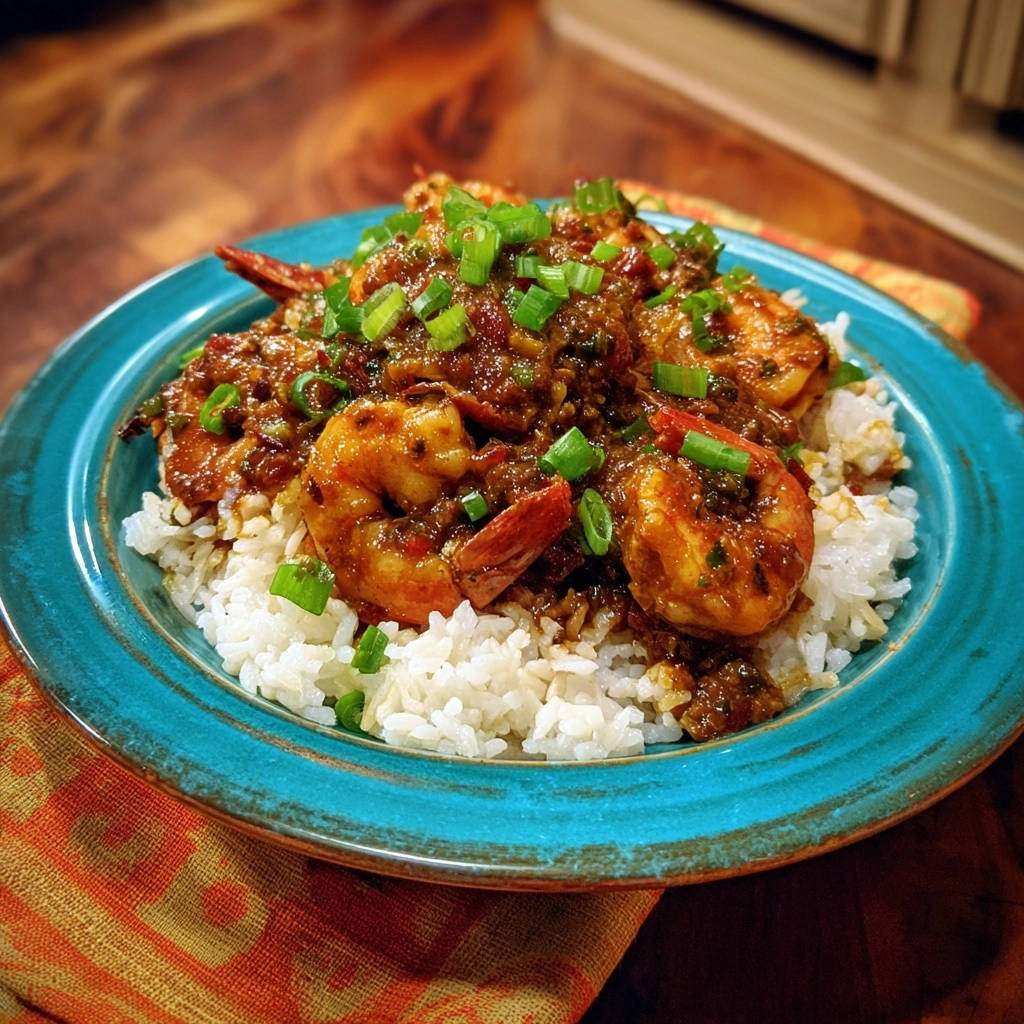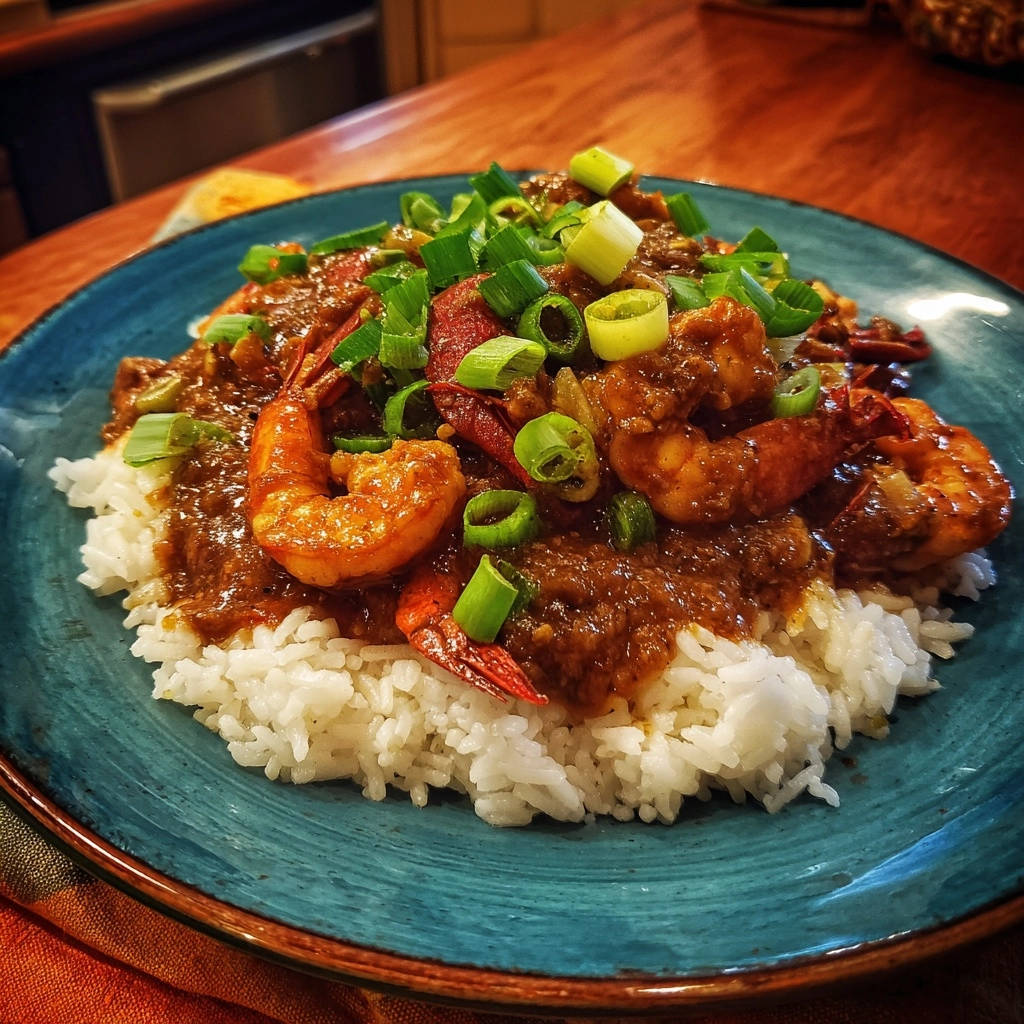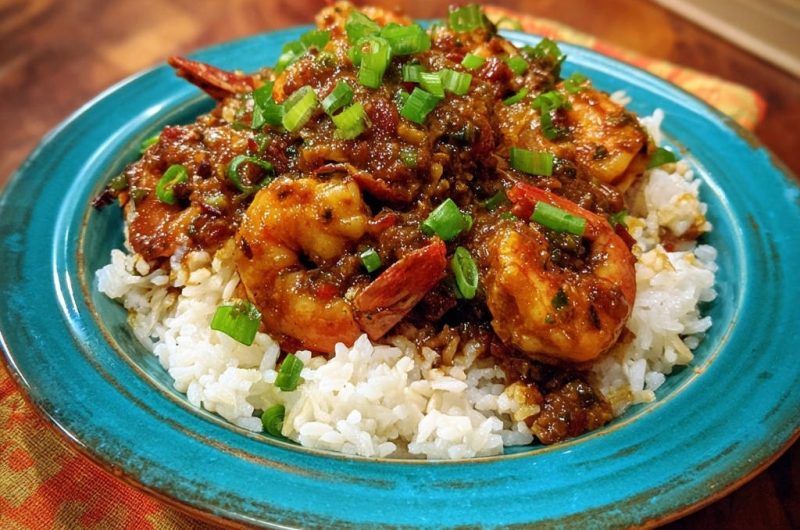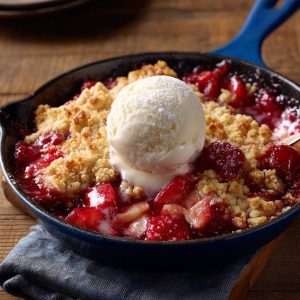For years, I struggled to achieve that perfect, tender bite of seafood while still capturing the deep, complex flavors required for authentic Cajun cuisine. The secret to mastering New Orleans Style Cajun Shrimp isn’t about the spice blend; it’s entirely about the method.
This recipe focuses on developing the rich sauce foundation first, allowing the aromatic spices to deepen while guaranteeing your shrimp achieves a flawless, silky texture every time.
The Secret to Silky, Never-Rubbery Cajun Shrimp
The common mistake is adding the shrimp too early, causing them to stew in the liquid as the sauce attempts to reduce and thicken.
This process leaches moisture from the seafood and causes the delicate protein fibers to contract excessively, resulting in rubbery, unsatisfying shrimp.
By building and thickening the sauce base first, we create a hot, concentrated environment that quickly sears the shrimp.
Introducing the seafood for just 2 to 3 minutes per side prevents overcooking and locks in a beautifully succulent texture, delivering maximum flavor absorption with minimal cook time.
Building Blocks of Flavor: Key Ingredients and Their Purpose
The Essential “Holy Trinity”
The Holy Trinity-onion, bell pepper, and garlic-forms the absolute foundation of this dish’s savory profile, characteristic of classic Creole cooking.
Cooking these vegetables slowly for 6 to 8 minutes is critical, allowing them to soften and caramelize slightly.
This patient sautéing releases their natural sugars and adds irreplaceable, deep sweetness to the final Cajun shrimp sauce.
Crafting the Deep Cajun Spice Blend
Smoked paprika is essential here, providing a subtle, woodsy complexity that traditional sweet paprika cannot replicate.
We recommend starting with a salt-free Cajun seasoning blend so you can precisely control the final sodium level after the sauce has reduced and concentrated its flavor.
To maximize flavor extraction, you must toast the dry spices with the tomato paste and fat for one minute; this crucial “blooming” process awakens the volatile oils in the seasonings.
The Rich Liquid Foundation
Tomato paste is highly concentrated, adding intense umami and a deep color without watering down the sauce.
A splash of Worcestershire sauce provides a savory tang and complexity that balances the heat of the cayenne and paprika.
We use low-sodium broth to maintain control over the final salt content while providing the necessary liquid for the sauce reduction.
Prepping for Success: Essential Tools and Ingredient Handling
You will need a large, heavy-bottomed skillet or deep sauté pan that retains heat well for this recipe.
Ensure you have plenty of paper towels ready, as meticulous ingredient preparation is just as crucial as the cooking technique.
Why Drying the Shrimp is the Single Most Important Prep Step
Moisture is the enemy of a thick, flavorful sauce and prevents the shrimp from achieving a proper sear.
If the shrimp are wet, they will instantly cool the pan and release excess water, immediately thinning out your rich sauce base.
Pat the peeled and deveined shrimp absolutely dry using paper towels until they no longer feel tacky before you set them aside.
The Benefits of Using Peeled, Deveined, Tail-On Shrimp
While peeled shrimp is easier to eat, leaving the tail on adds excellent visual appeal and helps infuse a subtle extra layer of shellfish flavor into the simmering sauce.
This New Orleans Style Cajun Shrimp recipe works perfectly fine with frozen shrimp, provided they are completely thawed under refrigeration and then meticulously dried before cooking.
The 30-Minute Master Plan: Step-by-Step Cajun Shrimp Directions
-
Step 1: Build the Flavor Base (Fat and Aromatics)
Melt 2 tablespoons of butter with the olive oil in your large skillet over medium heat.
Add the diced onion and bell pepper and cook patiently for 6 to 8 minutes until they are soft and beginning to develop a golden-brown hue, then add the minced garlic for just one minute until fragrant.
-
Step 2: Toast the Spices and Tomato Paste
Stir in the tomato paste, Cajun seasoning, smoked paprika, and cayenne pepper.
Cook this vibrant mixture for exactly 60 seconds, stirring constantly; this brief toasting period is essential for unlocking the full, deep flavor potential of your spices (the bloom).
-
Step 3: Creating the Rich Liquid and Reduction
Pour in the broth and the Worcestershire sauce to deglaze the pan, scraping up all the savory browned bits from the bottom, known as the fond.
Reduce the heat to low and let the sauce simmer for 5 to 7 minutes until it has visibly reduced and thickened to a consistency that will beautifully coat the shrimp.
Taste the reduced sauce now and adjust the seasoning with salt and pepper, remembering that the flavors will concentrate further.
-
Step 4: The Final Butter Emulsion and Shrimp Introduction
Remove the pan from the heat momentarily and stir in the remaining 2 tablespoons of butter until it is completely melted and incorporated.
This emulsified fat gives the finished sauce its signature glossy finish and deep richness, balancing the spices perfectly.
Increase the heat to medium-high and add the thoroughly dried shrimp, spreading them out in as close to a single layer as your pan allows.
-
Step 5: The Quick-Cook Guarantee for Tender Shrimp
Cook the shrimp for only 2 to 3 minutes per side until they turn opaque and pink, ensuring you stir them only once to promote a quick sear rather than stewing.
The moment the shrimp are just curled and fully pink, immediately remove the entire pan from the heat source to prevent the latent heat from continuing the cooking process and making them tough.
-
Step 6: Finish and Serve
Stir in the fresh chopped parsley for a bright, herbal counterpoint to the rich sauce.
Serve the luxurious New Orleans Style Cajun Shrimp immediately over hot white rice, garnishing generously with sliced green onions.
Chef’s Secrets: Elevating Texture and Depth of Flavor
-
Avoid the Cajun Seasoning Trap: Many commercial blends are extremely high in salt, making precise seasoning control impossible after reduction.
Using a salt-free blend first allows you to measure the heat and spice, adding sodium only after the sauce has reached its final concentrated volume.
-
Use High-Quality Butter: Because butter is used twice and is central to the flavor and texture, choosing unsalted, high-fat European-style butter will vastly improve the richness and glossy mouthfeel of the final sauce.
-
The Immediate Removal Rule: As soon as the shrimp are pink and just starting to curl, take the pan completely off the heat-do not leave it on a cooling burner.
Even residual heat on the stovetop can continue cooking the delicate proteins, turning them rubbery within a minute or two.
-
Don’t Rush the Reduction: Allowing the sauce to simmer for the full 5-7 minutes in Step 3 is non-negotiable.
This concentration step is where the sauce develops the necessary body and intensity needed to properly coat the shrimp without being watery.
Troubleshooting Common Cajun Shrimp Challenges
Why is my sauce too thin?
Your sauce base was likely not reduced for the full 5-7 minutes, meaning there was too much liquid when the shrimp were added.
The other major culprit is improperly dried shrimp, which released excess water into the pan; a quick fix is stirring in a slurry of 1 teaspoon cornstarch mixed with 2 teaspoons cold water.
The shrimp came out tough and chewy.
Tough shrimp indicates they were exposed to heat for too long, either by stirring them too often or by failing to remove the pan immediately when they finished cooking.
The heat must be medium-high when the shrimp are introduced to ensure they sear quickly rather than stewing in the sauce.
My sauce lacks that authentic deep flavor.
Authentic flavor requires patience in the initial stages: ensure the Holy Trinity cooked long enough to truly soften and brown.
If you skipped the critical step of toasting the spices with the tomato paste (blooming), the flavor profile will remain flat and underdeveloped.
Perfect Pairings: What to Serve with Your New Orleans Style Cajun Shrimp
The traditional and most satisfying pairing for this rich Cajun shrimp dish is simple, hot white rice, which effortlessly soaks up every drop of the intensely flavored sauce.
Beyond the Basics: Side Dish Ideas
-
Creamy, Cheesy Grits (Transforms this dinner into an incredible brunch dish, often called “Shrimp and Grits”).
-
Crisp, Cool Coleslaw (Provides a necessary textural contrast and cooling acidity to cut through the richness of the sauce).
-
Southern Cornbread or crusty French Bread (Ideal for mopping up any leftover sauce, ensuring nothing goes to waste).
Make-Ahead Tips and Safely Storing Leftovers
Can I make the sauce base ahead of time?
Absolutely! You can prepare the entire sauce base-up to Step 3 (Creating the Rich Liquid and Reduction)-up to three days in advance.
Cool the sauce completely and store it in an airtight container; when ready to serve, simply reheat the sauce and proceed with Step 4 (adding the final butter and shrimp).
Reheating Leftover New Orleans Style Cajun Shrimp
Shrimp is always best enjoyed fresh, but if you have leftovers, reheat them gently to preserve the texture.
The best method is to reheat the shrimp and sauce in a skillet over low heat, perhaps adding a small splash of broth to prevent drying out.
Common Questions About New Orleans Style Cajun Shrimp (FAQ)
How Spicy is This Recipe?
The base recipe is balanced at a mild-to-medium heat level, deriving warmth primarily from the cayenne pepper.
For milder heat, omit the cayenne entirely; for extra spice, you can easily double the amount or add a dash of your favorite Louisiana-style hot sauce at the end.
What if I don’t have Worcestershire sauce?
Worcestershire sauce is used primarily for its deep, fermented umami flavor and subtle acidity.
A suitable substitution would be an equal amount of soy sauce or coconut aminos, which provide a similar savory depth.
Do I have to use butter, or can I use only olive oil?
While you could technically use only oil, the use of high-fat unsalted butter, added twice, is fundamental to the richness and luxurious mouthfeel of authentic Creole/Cajun sauces.
The final addition of butter creates a vital emulsion that gives the sauce its signature gloss and ensures the proper quick sear when the shrimp are introduced.
Bringing the Taste of the Bayou to Your Table
This New Orleans Style Cajun Shrimp recipe removes the guesswork, promising that sought-after deep flavor and guaranteeing a perfectly tender bite of seafood every single time.
By prioritizing the sauce reduction and mastering the quick-cook method, you can bring the vibrant, rich flavors of the Bayou right into your own kitchen tonight.
Try this method immediately, and share the secret of your flawlessly tender shrimp with everyone you know.
New Orleans Style Cajun Shrimp
Course: Main CourseCuisine: American CuisineDifficulty: easy4
servings10
minutes20
minutes30
minutesAmerican Cuisine
Ingredients
1 pound large shrimp, peeled and deveined (tail on is fine)
1 tablespoon olive oil
4 tablespoons unsalted butter, divided
1/2 cup finely diced yellow onion
1/4 cup finely diced green bell pepper
3 cloves garlic, minced
1 tablespoon tomato paste
1 teaspoon Worcestershire sauce
1 cup low sodium chicken or vegetable broth
1 tablespoon Cajun seasoning blend (salt-free preferred, as you will add salt later)
1/2 teaspoon smoked paprika
1/4 teaspoon cayenne pepper (adjust to taste)
Salt and black pepper to taste
2 tablespoons fresh parsley, chopped
3 cups cooked white rice, for serving
2 green onions, sliced, for garnish
Directions
- Prepare the Base and Seasoning. Pat the shrimp thoroughly dry with paper towels. Set aside. This prevents the sauce from thinning out later.
- Build the Sauce Base. In a large skillet or deep pan, melt 2 tablespoons of butter with the olive oil over medium heat. Add the diced onion and bell pepper and cook for 6 to 8 minutes until softened and starting to brown lightly. Add the minced garlic and cook for 1 minute until fragrant.
- Develop the Flavor. Stir in the tomato paste, Cajun seasoning, smoked paprika, and cayenne. Cook for 1 minute, stirring constantly, allowing the spices to toast slightly. This deepens the flavor of the sauce significantly.
- Create the Rich Liquid. Deglaze the pan by pouring in the broth and the Worcestershire sauce. Bring the mixture to a simmer, scraping up any browned bits from the bottom of the pan. Reduce the heat to low and let the sauce simmer for 5 to 7 minutes until it has reduced slightly and thickened to your desired consistency. Taste and adjust seasoning with salt and pepper.
- Guarantee Tender Shrimp. Push the sauce to the sides of the pan slightly, creating a space in the center, or remove the entire pan from the heat source temporarily. Add the remaining 2 tablespoons of butter to the sauce base and let it melt, stirring it in completely. Increase the heat to medium-high. Add the dried shrimp directly into the thickened sauce, spreading them in a single layer if possible.
- The Quick Cook Method. Cook the shrimp for 2 to 3 minutes per side, stirring only once, until they are opaque and pink. This quick sear in the already developed sauce prevents them from stewing and turning tough. The key is to remove the pan from the heat immediately once the shrimp have just finished curling and are perfectly pink.
- Finish and Serve. Stir in the fresh parsley. Serve the rich shrimp and sauce immediately over hot white rice, garnishing generously with sliced green onions.
Notes
- Ensure the shrimp are patted dry before cooking to prevent the sauce from thinning out. The sauce must be fully developed before the shrimp are added for perfect texture.






